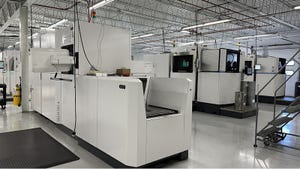November 1, 1999

Schaumburg, IL-Major advancements in solid-state relay (SSR) technology have warranted more than a second look at these devices for applications that have--until recently--been largely dominated by EMRs (electromechanical relays). These devices are finding use in applications ranging from industrial process control to exercise equipment, where a fail-safe open condition, enhanced reliability, and size play critical roles. Another key factor has been a decrease in SSR cost both at the product and design level.
While major advancements in technologies have increased the use of SSRs in recent years, several factors should be considered before deciding which type of relay to use in specific applications. Both EMRs and SSRs are used to isolate sensitive circuitry from harsh or external electrical environments and to switch a load or external device on or off. However, the manner in which these devices make their connections differs greatly. An SSR relies on semiconductors and photoelectric devices to provide electrical isolation between a control circuit (input) and a load circuit (output), while EMRs use an input voltage to magnetize a core that physically moves contactors together or apart to open or close a circuit.
Determining which relay type fits your application typically comes down to size, and performance, and price. Because of their semiconductor technology-based design, SSRs provide a higher degree of reliability, longer life and reduced electromagnetic interference (EMI), as well as faster response times and vibration and shock resistance, when compared to the EMR counterparts. This is due to the fact that SSRs have no mechanical contacts to wear out or arc, which is the primary cause for EMR failure.

An SSR has no moving parts to wear off. |
Average lifetime is another consideration. Typically, SSRs will operate for billions of cycles, while the useful life of an EMR with a rating of 1 million cycles could be too short in a fast switching application. To activate its coil, a typical power relay may require 100mA or more, while an SSR can typically be driven from 10-20mA, making SSRs compatible with IC logic families used in computers and industrial process control applications.
But, EMRs typically have a lower voltage drop than SSRs, which tend to dissipate more power and sometimes require heat sinking. And, for applications that demand anything other than a single-pole, single-throw, normally open (SPST-NO) relay, an EMR is typically a better choice because the cost of SSRs increases dramatically for configurations other than SPST-NO.
Because of their performance characteristics and size, SSRs have steadily found increased use in digital logic applications like industrial process control where size (for rack density) and performance (for rapid cycle time) have set the standards. Another key to the popularity of SSRs in this arena is their low input current requirement, which allows them to operate directly from digital logic circuitry.
Despite the advantages of SSRs, EMRs will continue to be used in many applications, including those that do not require an extremely long life cycle or where the cost of an SSR is not justified by the application requirements.
How solid-state relays work
Solid-state relay (SSR) operation relies on two key internal components: an optical coupling device to provide isolation and a solid-state switching device in the output. The most common types of optical coupling devices are photocouplers and phototriacs. The output device consists of a solid-state switching element: a triac , SCR (silicon-controlled rectifier), or thyristor for AC outputs, a bipolar junction transistor for DC outputs, or a MOSFET to switch both AC and DC loads.
Basic operation consists of the optical coupling device receiving a signal from the input of the SSR and transferring the information to the output device, thus switching on the output load. Since there are no moving components inside the SSR, as there are with electromechanical relays, there is no physical wear on the internal components, thus giving the SSR longer life and greater reliability. With additional built-in features such as zero cross circuitry, snubber circuits, and built-in varistors, solid-state relays offer many features that can improve the life of the load and provide a reliable solution for virtually any application. And the latest Omron models fail open, or safe, using a wirebond stress notch to focus over-current-generated heat, protecting the triac.
The pros and cons
|
|
|
|
|
|
|
|
|
|
|
|
| |
| |
| |
| |
| |
| |
|
|
|
|
|
|
|
|
|
|
|
|
|
|
|
|
|
About the Author(s)
You May Also Like





